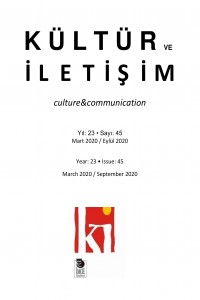Öz
Video games borrow fictional worlds from other media or create their own unique worlds to
spread to a wider audience but how these virtual worlds are created or what kind of
components are used to build them are important questions that can be studied well with a
systematic analysis of their content. It is also important to note here that once a fictional world
is successful for one type of media, it usually expands through different media, which is defined
as media narrative convergence or transmedia storytelling. This study attempts to find out the
patterns and trends of worldbuilding methods in the fictional worlds of computer role-playing
games. Adopting a systematic content analysis approach, 10 most successful computer roleplaying
games are analyzed to identify their worldbuilding components and transmedial
extensions. The analysis of video games includes information about the game world (world
type, world map, distinct elements), points of interest and their corresponding map icons,
species found in the fictional world (player species, flora, fungi, creatures, sentient species),
information about culture (religion, language, government type, social organizations, the use
of magic or technology). In this regard, repeating patterns of worldbuilding in games are
presented and the framework that consists of three components (place, species, culture). The
effects of each fictional world on different media are also given.
Anahtar Kelimeler
Kaynakça
- Adams, Ernest (2014). Fundamentals of Game Design. San Francisco, CA: New Riders.
- Baker, Neal (2016). “Secondary World Infrastructures and Tabletop Fantasy Role- Playing Games.” In Revisiting Imaginary Worlds: A Subcreation Studies Anthology. Mark J. P. Wolf (eds.). New York: Routledge. 113-125.
- Baur, Wolfgang (2012). “What Is Setting Design.” In The KOBOLD Guide to Worldbuilding. Janna Silverstein. Kirkland: Open Design LLC. 8-12.
- Brand, Jeffrey E., Scott Knight and Jakub Majewski (2003, November). “The Diverse Worlds of Computer Games: A Content Analysis of Spaces, Populations, Styles and Narratives.” In DiGRA Conference.
- Bourdaa, Melanie (2014). “This is Not Marketing. This is HBO: Branding HBO with Transmedia Storytelling.” Networking Knowledge: Journal of The MeCCSA Postgraduate Network, 7(1): 18-25.
- Castronova, Edward (2008). Synthetic Worlds: The Business and Culture of Online Games. London: University of Chicago Press.
- DeMaria, Rusel and David Perry (2014). David Perry On Game Design: A Brainstorming Toolbox. Boston, MA: Cengage Learning.
- Dena, Christy (2009). “Transmedia Practice: Theorising the Practice of Expressing a Fictional World Across Distinct Media and Environments.” Doctoral dissertation, University of Sydney.
- Dietz, Tracy L. (1998). “An Examination of Violence and Gender Role Portrayals in Video Games: Implications for Gender Socialization and Aggressive Behavior.” Sex Roles, 38(5-6): 425-442.
- Dowd, Tom (2015). Storytelling Across Worlds: Transmedia for Creatives and Producers. New York and London: Focal Press.
- Ekman, Stefan (2013). Here Be Dragons: Exploring Fantasy Maps and Settings. Middletown, Connecticut: Wesleyan University Press.
- Elkington, Trevor (2008). “Too Many Cooks: Media Convergence and Self-defeating Adaptations.” In The Video Game Theory Reader 2. New York: Routledge. 235- 258.
- Fast, Karin and Henrik Örnebring (2017). “Transmedia World-Building: The Shadow (1931–present) and Transformers (1984–present).” International Journal of Cultural Studies, 20(6): 636-652.
- Fullerton, Tracy (2018). Game Design Workshop: A Playcentric Approach to Creating Innovative Games. New York: Crc Press.
- Gambarato, Renira Rampazzo (2013). “Transmedia Project Design: Theoretical and Analytical Considerations.” Baltic Screen Media Review, 1(1): 80-100.
- Goodman, Nelson (1978). Ways of Worldmaking (Vol. 51). Indianapolis, Indiana: Hackett Publishing.
- Greenwood, Ed (2001). Forgotten Realms: Dungeons & Dragons Campaign Setting. Renton, WA: Wizards of the Coast.
- Gygax, Gary and Dan Cross (2004). Gary Gygax’s World Builder. Arkansan, USA: Troll Lord Games.
- Huizinga, Johan (1949) Homo Ludens: A Study of The Play ElementIin Culture. 3rd edn. London: Routledge & Kegan Paul.
- Jenkins, Henry (2003). “Transmedia Storytelling: Moving Characters from Books to Films to Video Games Can Make Them Stronger and More Compelling.” www.technologyreview.com. Access date: 20.08.2019.
- Jenkins, Henry (2006). Convergence Culture: Where Old and New Media Collide. New York and London: NYU press.
- Jenkins, Henry (2014). “The Reign of the ‘Mothership’: Transmedia’s Past, Present, And Possible Futures.” Wired TV: Laboring Over an Interactive Future. Denise Mann (eds.). London: Rutgers University Press. 244-268.
- Johnson, Derek (2013). “A History of Transmedia Entertainment.” www.spreadablemedia.org. Access date: 02.09.2019.
- Juul, Jesper (2003). “The Game, The Player, The World: Looking for A Heart of Gameness.” In Level Up: Digital Games Research Conference Proceedings. 4-6 November 2003.
- Juul, Jesper (2011). Half-real: Video Games Between Real Rules and Fictional Worlds. London: MIT press.
Ayrıntılar
| Birincil Dil | İngilizce |
|---|---|
| Konular | İletişim ve Medya Çalışmaları, Kültürel çalışmalar |
| Bölüm | Araştırma Makalesi |
| Yazarlar | |
| Yayımlanma Tarihi | 26 Mart 2020 |
| Yayımlandığı Sayı | Yıl 2020 Cilt: 23(1) Sayı: 45 |


